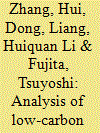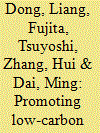|
|
|
Sort Order |
|
|
|
Items / Page
|
|
|
|
|
|
|
| Srl | Item |
| 1 |
ID:
125659


|
|
|
|
|
| Publication |
2013.
|
| Summary/Abstract |
CO2 mitigation strategies in industrial parks are a significant component of the Chinese climate change mitigation policy, and industrial symbiosis can provide specific CO2 mitigation opportunity. Technology is important to support symbiosis, but few studies in China have focused on this topic at the industrial park level. This research presented a case study in a national iron and steel industrial park in China. Focus was given onto carbon mitigation through industrial symbiosis technology using substance flow analysis (SFA). Three typical iron and steel industry technologies, including coke dry quenching (CDQ), combined cycle power plant (CCPP), and CO2 capture by slag carbonization (CCSC) were evaluated with SFA. Technology assessment was further conducted in terms of carbon mitigation potential and unit reduction cost. Compared with the Business as usual (BAU) scenario, application with CDQ, CCPP, and CCSC reduced the net carbon emissions by 56.18, 134.43, and 222.89 kg CO2 per ton crude steel inside the industrial parks, respectively, including both direct and indirect emissions. Economic assessment revealed that the unit costs for the three technologies were also high, thereby necessitating national financial support. Finally, relevant policy suggestions and future concerns were proposed and discussed.
|
|
|
|
|
|
|
|
|
|
|
|
|
|
|
|
| 2 |
ID:
121365


|
|
|
|
|
| Publication |
2013.
|
| Summary/Abstract |
Industrial parks have become the effective strategies for government to promote sustainable economic development due to the following advantages: shared infrastructure and concentrated industrial activities within planned areas. However, due to intensive energy consumption and dependence on fossil fuels, industrial parks have become the main areas for greenhouse gas emissions. Therefore, it is critical to quantify their carbon footprints so that appropriate emission reduction policies can be raised. The objective of this paper is to seek an appropriate method on evaluating the carbon footprint of one industrial park. The tiered hybrid LCA method was selected due to its advantages over other methods. Shenyang Economic and Technological Development Zone (SETDZ), a typical comprehensive industrial park in China, was chosen as a case study park. The results show that the total life cycle carbon footprint of SETDZ was 15.29 Mt, including 6.81 Mt onsite (direct) carbon footprint, 8.47 Mt upstream carbon footprint, and only 3201 t downstream carbon footprint. Analysis from industrial sector perspectives shows that chemical industry and manufacture of general purpose machinery and special purposes machinery sector were the two largest sectors for life cycle carbon footprint. Such a sector analysis may be useful for investigation of appropriate emission reduction policies.
|
|
|
|
|
|
|
|
|
|
|
|
|
|
|
|
| 3 |
ID:
125588


|
|
|
|
|
| Publication |
2013.
|
| Summary/Abstract |
China launched low-carbon city strategy to respond global climate change. Industrial symbiosis (IS) could generate both economic and environmental benefits in clustered industries and communities. This research shed light on how industrial symbiosis contributes to city's low-carbon development. An urban-level hybrid physical input and monetary output (HPIMO) model which covers physical energy inputs and air pollutants emissions, is established for addressing case study in a Chinese typical industrial city (Liuzhou). Based on current energy consumption and industrial symbiosis and the application of HPIMO model, scenarios related to industrial symbiosis, including waste plastics recycling, scrap tires recycling, flying ash recycling and biomass utilization are explored. Results show that compared with business-as-usual (BAU) scenario, IS can reduce solid wastes and further contribute to the co-benefits of energy saving, CO2 emissions reduction and air pollutants reduction. The finding is critical for national low-carbon strategy. Finally, policy implications to support the ever-improvement of IS promotion in China are proposed and discussed.
|
|
|
|
|
|
|
|
|
|
|
|
|
|
|
|
| 4 |
ID:
125651


|
|
|
|
|
| Publication |
2013.
|
| Summary/Abstract |
With rapid development, increasing sulfur dioxide (SO2) emission becomes a key environmental issue in China. To respond to this challenge, the Chinese government established a top-down scheme to reduce its SO2 emissions. However, regional disparity and the associated cost differences brought uncertainties to the policy effectiveness and efficiency. Few studies focus on this field. Therefore, this study tries to fill such a gap by investigating the differences of SO2 emissions, reduction potential, and cost-effectiveness through use of the GAINS-China model in five mega-cities in China, namely, Beijing, Shanghai, Tianjin, Chongqing, and Hong Kong. A scenario analysis approach is employed, focusing on two technologies named flue gas desulfurization (FGD) and limestone injection (LINJ). Results demonstrated that a large SO2 reduction potential exists, as well as a great disparity, among the five mega-cities. Chongqing had the largest reduction potential with lowest unit cost, while Beijng and Hong Kong showed the lowest reduction potential with higher unit cost. In Beijing and Shanghai, FGD and LINJ in the power generation sector had the larger reduction potential with the highest cost-effectiveness. However, in Chongqing, the industry sectors also had large reduction potentials. Finally, appropriate SO2 control strategies and policies are raised by considering the local realities.
|
|
|
|
|
|
|
|
|
|
|
|
|
|
|
|
| 5 |
ID:
127240


|
|
|
|
|
| Publication |
2014.
|
| Summary/Abstract |
There is a dilemma for rapid industrializing China to balance economic growth and low carbonization. Industrial symbiosis (IS) provides a system innovation to utilize the industry to fight climate change and pursue sustainable urban development, while few attentions are paid in literatures. Under this circumstance, this study reviews the low-carbon city practice in China and conducts a case study to calculate the CO2 emissions reduction potential under promoting IS projects in two cities of China, named Jinan and Liuzhou. With the real national project in Jinan as advanced example, new scenarios related to IS are designed for Liuzhou, including comprehensive energy network, waste plastics recycling, scrap tires recycling and flying ash recycling. The material/waste and energy exchange is quantified in the IS network, as well as the related environmental benefit. The material/energy exchange is over 10 million ton and 20 thousands tce in Jinan's case, and 2.5 million ton and 45 thousand tce in Liuzhou's case. Results highlight that IS could effectively reduce CO2 emissions. The total reduction potential amounts to 3944.05 thousands tCO2/year and 2347.88 thousands tCO2/year in Jinan and Liuzhou. Finally, policy implications on the ever-improvement of industrial symbiosis and China's sustainable urban development are proposed and discussed.
|
|
|
|
|
|
|
|
|
|
|
|
|
|
|
|
|
|
|
|
|